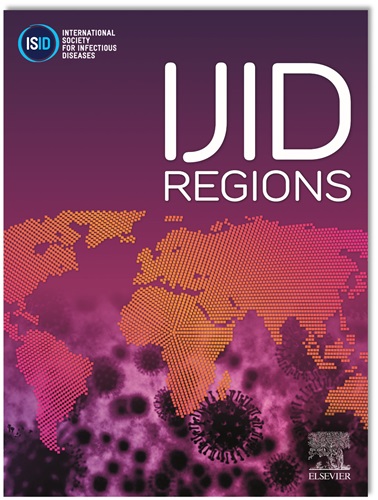Artemisinin combination therapy at delivery to prevent postpartum malaria: A randomised open-label controlled trial
IF 4.8
2区 医学
Q1 INFECTIOUS DISEASES
引用次数: 0
Abstract
Objectives
Although the incidence of malaria is increased in women in endemic areas after delivery compared to non-pregnant women, no studies have assessed the benefit of presumptive antimalarial treatment given postpartum.
Methods
A randomised controlled trial investigating the efficacy of antimalarial treatment in preventing postpartum malaria was performed in healthy Papua New Guinea mothers immediately following delivery. Participants were randomised 1:1 to no treatment (n = 90) or artemisinin combination therapy (ACT), with further 1:1 ACT randomisation to artemether-lumefantrine (AL; n = 45) or dihydroartemisinin-piperaquine (DP; n = 45). Standardised reviews were conducted monthly for 6 months, including clinical assessment, malaria screening and haemoglobin measurement. The primary endpoint was incidence of slide-positive malaria within 6 months of delivery.
Results
Of 183 recruited participants, 151 completed study procedures and were included in per-protocol analyses (no treatment n = 71, AL n = 40, DP, n = 40). Those allocated to ACT were significantly less likely to develop slide-positive malaria during the 6-month follow-up period compared to those who were untreated (n = 17 (21%) vs n = 27 (38%); P = 0.016; hazard ratio 0.49 (95% confidence intervals 0.27-0.90). There was no significant difference in malaria incidence between the two ACT groups.
Conclusion
A treatment course of ACT at time of delivery halved the incidence of malaria infection during the first 6-month postpartum.
预防产后疟疾的青蒿素综合疗法:随机开放标签对照试验:预防产后疟疾。
目标:虽然疟疾流行地区的妇女产后疟疾发病率比非孕妇高,但还没有研究评估产后进行推定抗疟治疗的益处:虽然疟疾流行地区的妇女产后疟疾发病率比非孕妇高,但还没有研究评估产后进行假定性抗疟治疗的益处:方法:一项随机对照试验调查了抗疟治疗对预防产后疟疾的疗效,试验对象是巴布亚新几内亚的健康产妇。参与者按 1:1 随机分配接受无治疗(90 人)或青蒿素综合疗法(ACT),再按 1:1 随机分配接受蒿甲醚-本芴醇(AL,45 人)或双氢青蒿素-哌喹(DP,45 人)。每月进行一次标准化复查,为期六个月,包括临床评估、疟疾筛查和血红蛋白测量。主要终点是分娩后 6 个月内滑动片阳性疟疾的发生率:在招募的 183 名参与者中,有 151 人完成了研究程序,并纳入了按方案进行的分析(无治疗者 71 人,AL 者 40 人,DP 者 40 人)。与未接受治疗者相比,接受青蒿素综合疗法治疗者在6个月随访期间出现滑动片阳性疟疾的可能性明显降低(n=17 (21%) 对 n=27 (38%);P=0-016;HR 0-49 (95% CI 0-27 to 0-90))。两组 ACT 患者的疟疾发病率无明显差异:结论:分娩时接受一个疗程的青蒿素综合疗法可将产后前 6 个月的疟疾感染率降低一半。
本文章由计算机程序翻译,如有差异,请以英文原文为准。
求助全文
约1分钟内获得全文
求助全文
来源期刊
CiteScore
18.90
自引率
2.40%
发文量
1020
审稿时长
30 days
期刊介绍:
International Journal of Infectious Diseases (IJID)
Publisher: International Society for Infectious Diseases
Publication Frequency: Monthly
Type: Peer-reviewed, Open Access
Scope:
Publishes original clinical and laboratory-based research.
Reports clinical trials, reviews, and some case reports.
Focuses on epidemiology, clinical diagnosis, treatment, and control of infectious diseases.
Emphasizes diseases common in under-resourced countries.

 求助内容:
求助内容: 应助结果提醒方式:
应助结果提醒方式:


